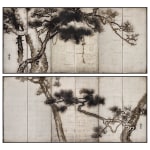UENAKA CHOKUSAI (1885-1977)
Pine Trees (Matsu no ki), circa 1910s
Pair of six-panel folding screens (byobu)
Sumi ink and silver leaf on paper
Sumi ink and silver leaf on paper
172 x 378 cm. (unfolded)
(67 3/4 x 148 7/8 in.)
(67 3/4 x 148 7/8 in.)
Signed and sealed: Chokusai
Sold
Further images
The trunks and over-hanging branches of Japanese pine trees fill the full height of this pair of screens. Rendered by brush entirely in varying intensities of black sumi ink onto...
The trunks and over-hanging branches of Japanese pine trees fill the full height of this pair of screens. Rendered by brush entirely in varying intensities of black sumi ink onto silver leaf applied to paper, the trees are both naturalistic and powerfully contemplative. The treatment of these trees is in the tradition of ink wash painting which originated in China during the Tang dynasty (618–907), which promoted virtuoso brushwork as well as communication of the ‘essence’, or ‘spirit’ of the subject, over realistic imitation. The rendering of the pine trees on these screens is reminiscent of the 18th century screen paintings of Maruyama Okyo (1733-1795) and other artists of the Maruyama-Shijo School.
Uenaka Chokusai was born in Nara and studied painting under Fukada Chokujyo (1861-1947), Hashimoto Gaho (1835-1908) and Yamamoto Shunkyo (1891-1933). He also became a disciple of Nichiren Buddhism under Tanaka Chigaku (1861-1939). His work is in the collection of The National Museum of Modern Art, Tokyo and The National Museum of Modern Art, Kyoto.
Uenaka Chokusai was born in Nara and studied painting under Fukada Chokujyo (1861-1947), Hashimoto Gaho (1835-1908) and Yamamoto Shunkyo (1891-1933). He also became a disciple of Nichiren Buddhism under Tanaka Chigaku (1861-1939). His work is in the collection of The National Museum of Modern Art, Tokyo and The National Museum of Modern Art, Kyoto.
21
of
21








